Viral Campaigns
> Jvlandaverde
> Social Media & Communication Strategies
Dyson va-t-il réussir son pari dans le véhicule électrique ?
Après les aspirateurs, les sèche-cheveux et les sèche-mains, la voiture électrique.
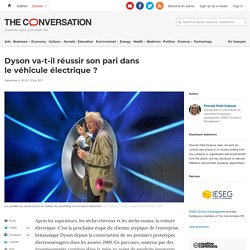
C’est la prochaine étape du chemin atypique de l’entreprise britannique Dyson depuis la construction de ses premiers prototypes électroménagers dans les années 1980. Ce parcours, soutenu par des investissements continus dans la mise au point de produits innovants, permet au fabricant d’afficher aujourd’hui plus de 4 milliards de livres sterling de chiffres d’affaires et un bénéfice de 1,1 milliard. Les gammes de traitement de l’air, les aspirateurs futuristes ou encore les sèche-cheveux Airwrap se vendent en effet toujours très bien. Sans conteste, une des clés du succès de Dyson réside en la personne de son fondateur, Sir James Dyson. Maître dans l’art du storytelling, James Dyson a su créer autour de sa personnalité une marque forte, avec une identité claire, qui se différencie par un design de rupture et des technologies avancées. Véhicule « androgyne, tout-terrain » Flou sur les batteries. The Science Behind What Content Goes Viral. We all want our content to go viral.
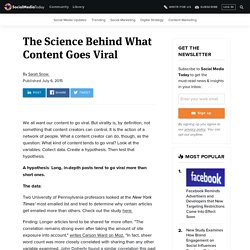
But virality is, by definition, not something that content creators can control. It is the action of a network of people. What a content creator can do, though, as the question: What kind of content tends to go viral? Look at the variables.
Lessons Learned From the 5 Biggest Brand Fails of 2017: Uber, Pepsi, Dove and More. Ever watch a particularly bad ad and wonder how it could have possibly made it past a team (teams!)
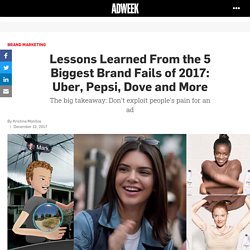
Of creatives and brand professionals, let alone out into the world? Well, here we are, at the end of 2017, with some of the most bizarre, off-putting, brand-tarnishing work of the year.
What Types of Content Get Shared on Social Media?
How Instagram, Google, Facebook and Other Tech Notables Are Getting Out the Vote. Tech companies are playing a role in getting voters to the polls.
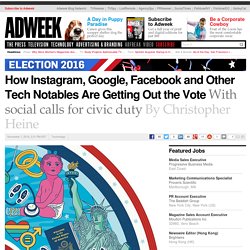
Why Internet-Famous Dogs Are Fetching So Much Love From Brands. The dapper Menswear Dog has done sponsored posts for J.Crew, Banana Republic and Gentleman's Box.
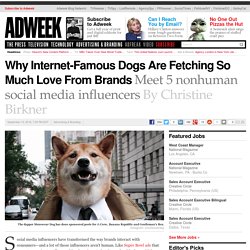
Social media influencers have transformed the way brands interact with consumers—and a lot of those influencers aren't human. Like Super Bowl ads that use cute puppies to sell everything from beer to ketchup, adorable dogs with huge social followings are getting a lot of love from brands these days. Dogs can fetch anywhere from $2,000 to $10,000 per sponsored post on Instagram, according to Rob Schutz, vp of growth at Bark & Co., parent company of BarkBox, a service that sends treats and other products to dog owners every month.
Bark & Co. works with brands like P&G's Swiffer, United Airlines, American Express and Anheuser-Busch to promote their products with dog influencers on social media.
6 Engaging Social Media Marketing Campaigns That Delivered Results. On Flipboard. The Obstacles and Opportunities of Connected Cars for Advertisers. The Customer Experience Reviews Sponsored By The Obstacles and Opportunities of Connected Cars for Advertisers How Smartphones and Smart Kitchens are Remaking the Home Cook These 'Non-Official Sponsors' Found Clever Ways to Sneak Their Brand Into Brazil For Brands, Virtual Reality is All About Genuine Connection.
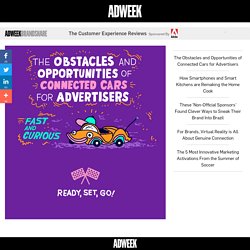
This Tourism Campaign's 'No Beachside Honeymooners' Rule Boosted Belize's GDP. ?mkt_tok=eyJpIjoiT0RBelpUQXhZVEJoWmpGbSIsInQiOiJOQk5HbUpVN21QWVBmZmE3UVg1MzVOYzJmNU9VYkZOSCt5OUJJTzI0YUZ1XC9pamp1aEozS0R0aHdlSFN6dFNnUUhxQ2o3eld2WGR6WUVROVZPaGc2YW94cmVXa21hZnRXTTVuRGNVOEdJUEk9In0=#sm. Coca-Cola is the longest continuous sponsor of the Olympics, going back almost 88 years.

The company first sponsored the 1928 Olympic Games in Amsterdam, and has supported every Olympics game since.
This Pepsi Spoof Aims to Ruin Cindy Crawford's Classic Ad Forever. A new ad from a consumer activist group is taking aim at Pepsi's sourcing practices by spoofing one of the soft drink company's most famous commercials—Cindy Crawford's roadside gas station spot from the 1992 Super Bowl.
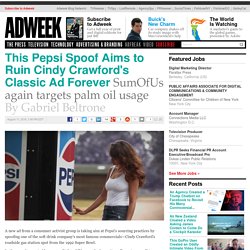
In the parody, created by nonprofit SumOfUs, a svelte brunette pulls up to a small town fueling station. Two young boys playing catch in a nearby yard stop and gape as she struts—in a tight white tanktop and cutoff shorts—to the vending machine, grabs a Crystal Pepsi and proceeds to chug it. The similarities to the original end there, as the scene takes a fast downward spiral into disturbing territory. Instead of fresh, clear Crystal Pepsi, a viscous yellow-brown substance oozes out of the upturned bottle and onto the Crawford stand-in's face. Unfazed, she lets the sludge run down her body, face contorted in grotesque ecstasy, while her admirers gag in horror.
3 Brands Using Facebook in Particularly Effective Ways During the Rio Games.
Thanks to the explosive growth of platforms like Snapchat, Instagram, Twitter and Facebook, the 2016 Rio Games are widely assumed to be the most social ever.
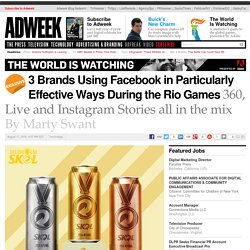
Six Essentials for Good Storytelling—and Great Content Marketing. "Storytelling" is often used loosely as a term for good writing.

Which makes me wonder: Do marketers actually understand storytelling in the context of content marketing?
Jan Rezab in re/code: Hope for Virality, Focus on Shareability. YouTube Videos: What’s not to like?
Brands spend a lot of money on promotional videos in hopes they can go viral; after all, what company doesn’t love word-of-mouth advertising? In addition to the displayed number of views, YouTube has a unique rating system that allows users to show whether they Like or Dislike a video, created in order to level the playing field and distribute content. Before March 2010, a 1–5 star rating system was used; a video could get more or fewer views based on this scale of popularity.
We analyzed nearly 5,000 brand channels with more than 28,000 videos over the course of one month. In general, people tend to Like YouTube videos more often than Disliking them. The average Like/Dislike ratio is 90%; this means that for every 9 likes, there is 1 dislike. Why are ratings so positive?
The Viral Marketing Cheat Sheet. Perhaps nothing is as effective and efficient in spreading your message as a viral marketing campaign. The idea behind viral marketing is to inspire people to spread your message for you. It’s been estimated that a successful viral campaign can have 500-1000 times more impact than a non-viral campaign.
Crafting a successful viral marketing campaign is more difficult than it looks. It requires careful planning and research. Use this cheat sheet to get started. Click on the image below to view an larger version of this infographic: View an enlarged version of this Infographic » Click here to download a .pdf version of this infographic. Simply copy and paste the code below into the html of your website to display the infographic presented above:
A Simple Framework for Creating a Viral Video. Viral Marketing. How These 10 Marketing Campaigns Became Viral Hits. This story first appeared in the May 2014 issue of Entrepreneur. To receive the magazine, click here to subscribe. Getting your brand noticed via social media grows more difficult with each passing day. Users upload 100 hours of video to YouTube every 60 seconds and share more than 4.75 billion pieces of content on Facebook every 24 hours.
A Simple Framework for Creating a Viral Video.
Nine Tips for Deploying a Measurable Viral Content Strategy. Examples of Viral Marketing Campaigns.










